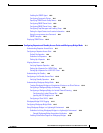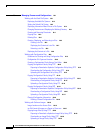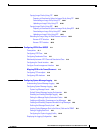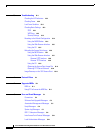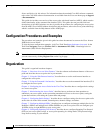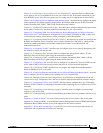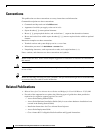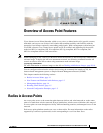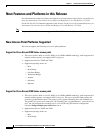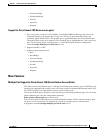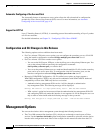
-xxi
Cisco IOS Software Configuration Guide for Cisco Aironet Access Points
OL-30644-01
Organization
Chapter 9, “Configuring an Access Point as a Local Authenticator,” describes how to configure the
access point to act as a local RADIUS server for your wireless LAN. If the WAN connection to your
main RADIUS server fails, the access point acts as a backup server to authenticate wireless devices.
Chapter 10, “Configuring WLAN Authentication and Encryption,” describes how to configure the cipher
suites required to use authenticated key management, Wired Equivalent Privacy (WEP), and WEP
features including MIC, CMIC, TKIP, CKIP, and broadcast key rotation.
Chapter 11, “Configuring Authentication Types,” describes how to configure authentication types on the
access point. Client devices use these authentication methods to join your network.
Chapter 12, “Configuring WDS, Fast Secure Roaming, Radio Management, and Wireless Intrusion
Detection Services,” describes how to configure the access point to participate in WDS, to allow fast
reassociation of roaming client services, and to participate in radio management.
Chapter 13, “Configuring RADIUS and TACACS+ Servers,” describes how to enable and configure the
RADIUS and Terminal Access Controller Access Control System Plus (TACACS+), which provide
detailed accounting information and flexible administrative control over authentication and
authorization processes.
Chapter 14, “Configuring VLANs,” describes how to configure your access point to interoperate with
the VLANs set up on your wired LAN.
Chapter 15, “Configuring QoS,” describes how to configure and manage MAC address, IP, and
EtherType filters on the access point using the web-browser interface.
Chapter 16, “Configuring Filters,” describes how to configure and manage MAC address, IP, and
EtherType filters on the access point using the web-browser interface.
Chapter 17, “Configuring CDP,” describes how to configure Cisco Discovery Protocol (CDP) on your
access point. CDP is a device-discovery protocol that runs on all Cisco network equipment.
Chapter 18, “Configuring SNMP,” describes how to configure the Simple Network Management
Protocol (SNMP) on your access point.
Chapter 19, “Configuring Repeater and Standby Access Points and Workgroup Bridge Mode,” describes
how to configure your access point as a hot standby unit or as a repeater unit.
Chapter 20, “Managing Firmware and Configurations,” describes how to manipulate the Flash file
system, how to copy configuration files, and how to archive (upload and download) software images.
Chapter 21, “Configuring L2TPv3 Over UDP/IP,” describes how to configure the Layer 2 Tunneling
Protocol (L2TPv3), which is a tunneling protocol that enables tunneling of Layer 2 packets over IP core
networks.
Chapter 22, “Configuring System Message Logging,” describes how to configure system message
logging on your access point.
Chapter 23, “Troubleshooting,”provides troubleshooting procedures for basic problems with the access
point.
Appendix A, “Protocol Filters,” lists some of the protocols that you can filter on the access point.
Appendix B, “Supported MIBs,” lists the Simple Network Management Protocol (SNMP) Management
Information Bases (MIBs) that the access point supports for this software release.
Appendix C, “Error and Event Messages,” lists the CLI error and event messages and provides an
explanation and recommended action for each message.



